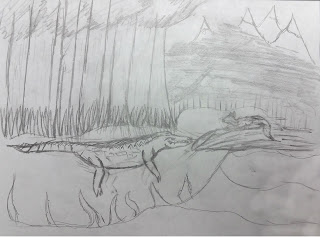What we had to do for this assignment is we would have to write about a scientific preservation method in order to demonstrate the overall theme of the class. What “scientific preservation method” is that it’s kept information on a species. It could either phenotype or genotype trails, but is phenotype for the most part. There are multiple types of preservations, such as video or picture, but I choose taxidermy, which is stuffing the skin in order to keep the shape. Anyway, I hope you all enjoy.
Taxidermy is a type natural preservation in which an animal carcass(non-decayed) has been stuffed and covered with certain materials in order to keep secure its preserved glory(removing the inners, of course). When you think about taxidermy, your mind comes to the conclusion of heads being mounted on walls and left for display. For the most part, that mounted heads is a good definition on how normal taxidermy looks like. But in order to give you a better idea, I need to give you an example.
| Ashish Sehgal. File:Taxidermy cat family. June 19, 2016. Wikipedia. Commons.wikimedia.org. Web. Oct 26, 2017 |
Above is a photo on the taxidermy of the two lions. We could tell it’s taxidermy mainly because the animals are in one signal pose, and doesn't show any signs of life. Now, there are several questions you could ask about these animals. Such as what species were they, where were these animals before, and how did they die. These questions are what taxidermy solves.
For example, if it was a video, you wouldn't be able to see the full model of the lions. It would just take wasted time and effort to record, since most of the time these species is always moving. What makes taxidermy so special is that you could be able to walk around and see every angle of the species. This would allow the scientist to conduct research just by appearance. You could see what type of lion they were, or even make a discovery that it’s a brand new species. You can measure the size/height of the animal with, rather than just creating assumptions through photos and videos. The same could be said for where they’re native to by seeing all of the color scheme on fur for camouflage as well as looking over the body for wounds on how they died.
Not only that, but this is a much safer way of gain research rather going into the field. When going into the field, you could have a risk of dying do to the animal trying to attack you. The animal could also run away, thus wasting more of you time trying to find it. It just makes things a bit too unnecessary. But with a model, hunters/other events already took the animal’s life. It gives a long term goal to keep it as a model and useful. We could say that taxidermy is extremely useful for scientist who observe in a lab rather than in the field.
In conclusion, I believe that taxidermy is one of the most important preservation methods by far. You can be able to interact with a model in a delicate way, as well a check on every single angle of the body. This allows future generations to look at a model to compare their size and height without gaining risk. Thus, I believe that taxidermy will be used for generations.
Ashish Sehgal. File:Taxidermy cat family. June 19, 2016. Wikipedia. Commons.wikimedia.org. Web. Oct 26, 2017
